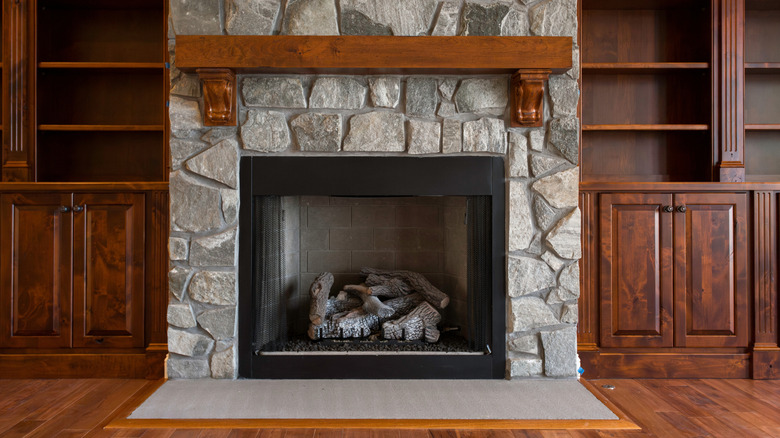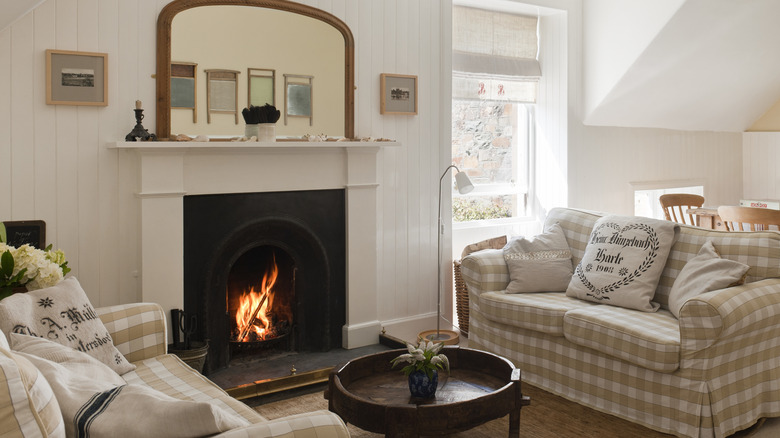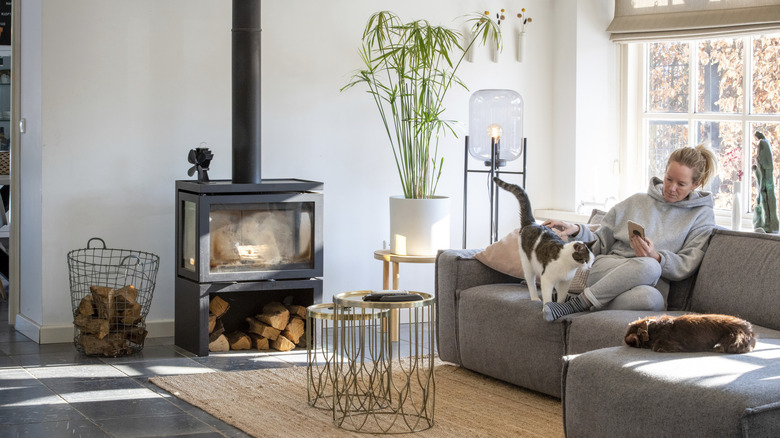Why Are So Many New Homes Being Built Without Fireplaces?
Fireplaces were originally used as the primary way to heat homes, as central heating wasn't always available. Even as they became less practical and central heating took over, fireplaces stayed around due to their charm. There's something nice about snuggling up on a cold, gray day in front of a crackling fire. They're also incredibly charming around the holidays when you can hang up stockings.
Unfortunately, fewer people are getting the chance to experience these moments. New homes with fireplaces are becoming a thing of the past. While there are a few benefits to buying a new construction home, fireplaces aren't necessarily one of them. Since 2015, the number of new homes with this feature has been declining. As of 2018, about 41% of single-family homes with construction started in that year had at least one fireplace, the National Association of Home Builders (NAHB) states, per an archived page on its Eye on Building blog. This was the lowest number to date since the records began in 2001. But when looking at homes with finished construction having a fireplace, that 2018 number hadn't been as low since as far back as 1973.
One of the most obvious reasons is cost. With homes already rising in price to the point that it makes them difficult to buy, cutting costs wherever possible is a must. There's also the fact that homes don't need fireplaces anymore. Central heating is growing more popular, so they aren't as important. Additionally, some homeowners just don't prioritize fireplaces as much. Roughly half of surveyed home buyers say a fireplace is the least desirable feature, and only 16% mark it as a dealbreaker if the house doesn't have one, per the NAHB report (via Builder).
Fireplaces aren't cheap options for new homes
It's not just the up-front cost that is reducing the number of fireplaces. Part of this is due to the long-term price of upkeep and to changes in values. A fireplace can sometimes be an annoying object in a room, when the central focus is now more often TVs. Those who may want one aren't necessarily able to afford it, while the ones who can might not find it worth the cost. The breakdown of fireplaces per price bracket also supports this theory. Although 41% of new homes built in 2018 had fireplaces, there were only 7% of homes under $150,000 constructed with one. Meanwhile, 60% of homes that cost $500,000 or more had at least one fireplace, according to the NAHB report.
Price might be the major reason new homes aren't being built with fireplaces anymore, but it's not the only one. While homes in colder climates are more likely to have fireplaces, it's still not very likely, as only 55% of houses constructed starting in 2018 in the Middle Atlantic and West North Central region had one built. Further, gas and wood-burning stoves pose danger to users, especially if not vented properly. Maintenance is also an issue and is a major hidden downside to traditional fireplaces. Wood-burning, gas, and even electric fireplaces need various levels of regular care and maintenance. Then, for those with chimneys, there is also the issue of opening your home up to more problems as it ages, such as leaks or condensation.
Alternatives to fireplaces in your new home
Though they are hard to find, there are a few reasons to decide to keep searching for a fireplace in your new home. For starters, they are costly to add in yourself, running several thousand dollars. There are also things to keep in mind before adding a fireplace to your home, such as where you would put it, if you can afford proper ventilation, and if you have the space for one. Certain fireplaces can be used as emergency heat if the power goes out. In really cold locations, a fireplace can be a lifesaver in the winter months. Additionally, there are still hundreds of thousands of households throughout the United States that rely on wood fuel as a primary heating source, meaning central heating isn't prominent everywhere.
If these benefits aren't swaying you, it may be time to consider one of the alternatives to a traditional fireplace. Freestanding wood stoves are one example. They can generate a large amount of heat more efficiently than fireplaces, but they pose a safety risk, especially around pets and children. If you like the aesthetic of a fireplace but you don't really plan to use it, try a decorative one. They provide the charm, but you don't have to actually worry about safety concerns or regular maintenance.


